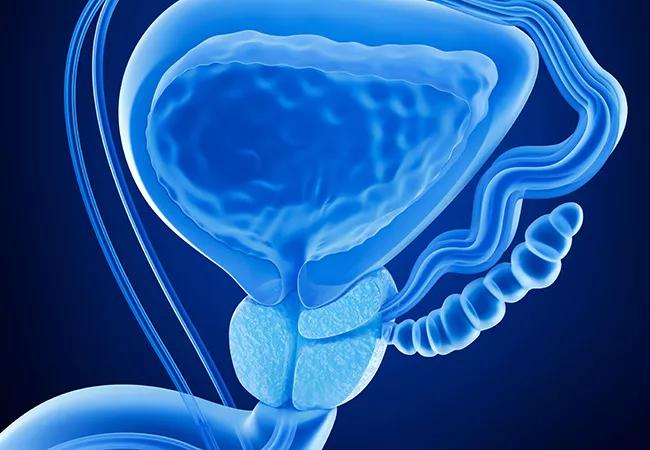Advanced training is linked to positive biopsy findings

Urologists who have completed urologic oncology fellowships are significantly more likely to detect prostate cancer via biopsy than are urologists who lack the advanced training, a new Cleveland Clinic study has found.
Advertisement
Cleveland Clinic is a non-profit academic medical center. Advertising on our site helps support our mission. We do not endorse non-Cleveland Clinic products or services. Policy
The difference in diagnostic yield may be due to how urologists with varied training levels select patients for biopsy and the biopsy techniques they use, the study’s authors conclude.
The results were presented at the American Society of Clinical Oncology’s Genitourinary Cancers Symposium in February 2019.
Urology resident Molly E. DeWitt-Foy, MD, and her mentor, urologist Robert Abouassaly, MD, co-led this retrospective study that reviewed 11,255 prostate biopsies performed at Cleveland Clinic locations between 2000 and 2018.
“This research was motivated by a study published in the United Kingdom that showed that urology consultants [attending urologists] had a higher diagnostic yield on prostate biopsy than junior trainees, but paradoxically, the same study showed that consultants with the highest level of training had a lower percent of high-risk pathology,” says Dr. DeWitt-Foy. “Because this study was performed on a small sample size, we thought it would be useful to examine this association in a large patient cohort here at Cleveland Clinic.”
Prostate biopsy is a diagnostic procedure commonly performed for patients with elevated levels of prostate specific antigen (PSA), those with abnormal digital rectal exam (DRE) findings, or patients on active surveillance due to a prostate cancer diagnosis. Studies have shown that numerous factors can influence the diagnostic yield of prostate biopsy, including patient factors such as age and race. Less is known about the effects of provider-related factors such as clinical experience and training, which adds to the significance of Dr. DeWitt-Foy’s research.
Advertisement
Of the 11,255 biopsies performed by 129 urologists and reviewed in the study, 35.5 percent were positive for prostate cancer. The study found that the rate of positive biopsies was significantly higher among urologists who had completed urologic oncology fellowship training (UOFT) than for those without UOFT (40.7 percent vs. 32.43 percent, p < 0.0001). Urologists with UOFT were more likely to use magnetic resonance imaging (MRI) during biopsy than urologists without UOFT (7.73 percent vs. 2.89 percent). Longer duration of clinical practice (> 5 years) was correlated with higher chances of positive biopsy, but when the results were adjusted for oncology fellowship, the significance of this association was lost.
“We found that urologists who completed UOFT were more likely to get a positive biopsy and more likely to get a high-risk positive biopsy, even when we adjusted the results for patient factors such as PSA, age and race,” says Dr. DeWitt-Foy. “We think that some of our findings may be explained by the actual patient selection process, and the rest by the level of adherence to the guidelines and uptake of new technologies used in the biopsy procedure, such as magnetic resonance imaging.”
Dr. DeWitt-Foy explains that the current American Urological Association (AUA) and National Comprehensive Cancer Network (NCCN) guidelines recommend that providers take at least 12 cores for each biopsy to ensure coverage of the entire prostate gland. In the study, the likelihood of detecting high-risk biopsies (Gleason Score ³7) was positively correlated with UOFT training, but when the results were adjusted for the number of biopsies (at least 12 cores) the significance of this association was lost.
Advertisement
“The main take-away of this research is that it is important to follow the guidelines, take as many cores as the AUA recommends, use the current technology and think about the patient as a whole,” she says. “The significantly higher rate of positive biopsies in the UOFT group probably is related to a greater adherence to the guidelines and a closer review of the literature. I believe that as long as urologists with no UOFT also adhere to the guidelines and take an adequate number of cores, the rate of positive biopsies in this group will also increase.”
The study’s limitations include its retrospective design and not accounting for DRE findings and a patient’s family history, which may influence the physician’s decision whether to perform a biopsy. Dr. DeWitt-Foy says that future studies should more closely examine these factors and how they may influence the association between UOFT and the rate of positive biopsies.
“We could not adjust for DRE and family history because our database did not contain this information,” she says. “It would be interesting to take a closer look at these factors, since patients with a positive DRE and family history of prostate cancer are much more likely to be diagnosed with prostate cancer.”
Advertisement
Advertisement

Large retrospective study suggests DOACs are safe, effective alternative to low-molecular-weight heparin in complex patient population

Care paths and research initiatives aim to answer unmet clinical needs

Study shows high rate of hematologic responses, low rate of disease progression

Bispecific antibody bridging therapy deepens durability of BCMA CAR T-cell therapy without overlapping toxicities in patients with relapsed/refractory multiple myeloma

Phase 2 study brings pivotal advances in treatment efficacy and safety for the most challenging-to-treat population

Patient with quadruple refractory multiple myeloma achieves complete response with cell therapy

Distinct baseline immune profiles can predict response and resistance to different types of CAR-T cells.

National Blood Clot Alliance collaborates with faith-based organizations on first-of-its-kind church bus tour